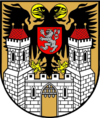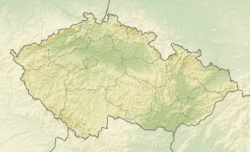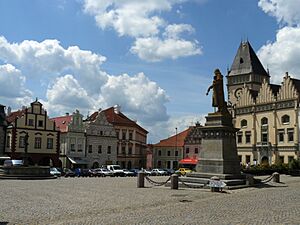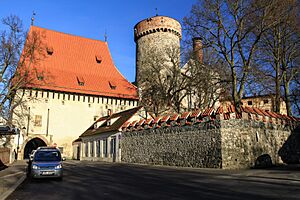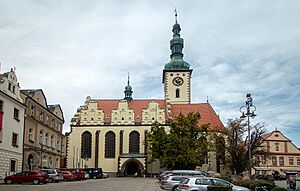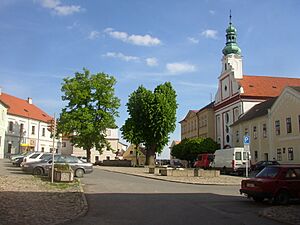Tábor facts for kids
Quick facts for kids
Tábor
|
|||
|---|---|---|---|
|
Town
|
|||
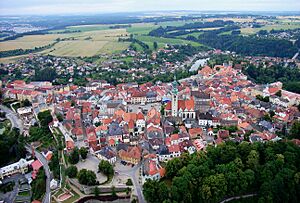
Aerial view of the old town
|
|||
|
|||
| Country | |||
| Region | South Bohemian | ||
| District | Tábor | ||
| Founded | 1420 | ||
| Area | |||
| • Total | 62.22 km2 (24.02 sq mi) | ||
| Elevation | 437 m (1,434 ft) | ||
| Population
(2024-01-01)
|
|||
| • Total | 34,370 | ||
| • Density | 552.39/km2 (1,430.7/sq mi) | ||
| Time zone | UTC+1 (CET) | ||
| • Summer (DST) | UTC+2 (CEST) | ||
| Postal code |
390 01
|
||
Tábor is a town in the South Bohemian Region of the Czech Republic. It has about 34,000 people living there. This makes it the second biggest town in the region. The town was started by a group called the Hussites in 1420. The old part of the town is very well kept. It is protected by law as a special historic area.
Contents
Parts of Tábor
Tábor is made up of several smaller villages. These villages are part of the town's administration:
- Čekanice
- Čelkovice
- Hlinice
- Horky
- Klokoty
- Měšice
- Náchod
- Smyslov
- Stoklasná Lhota
- Větrovy
- Všechov
- Zahrádka
- Záluží
- Zárybničná Lhota
What Does Tábor Mean?
The name Tábor comes from the biblical Mount Tabor in Israel. Even though the Czech word "Tábor" means "camp," the town's name came first. The town also gave its name to the Taborites. They were a strong group of the Hussites. At first, the town was called Hradiště hory Tábor. This means "fortified settlement of the Tábor mountain."
Tábor's Location and Nature
Tábor is about 50 kilometers (31 miles) north of České Budějovice. It is also about 70 kilometers (43 miles) south of Prague. The town sits on the Lužnice River.
Tábor is located in the Tábor Uplands. The highest point is Hýlačka hill, which is 525 meters (1,722 feet) high. The lowest point is the Lužnice River. The old town is on a hill above the river. This location helped protect the town long ago.
Jordán Reservoir: Central Europe's Oldest
In the middle of Tábor is the Jordán Reservoir. It was built in 1492. It was named after the biblical Jordan River. This reservoir was first used to store water. Today, people mostly use it for fun activities. It is the oldest reservoir in Central Europe. There are also many fish ponds around the town.
A Look Back: Tábor's History
People lived in this area a very long time ago. Evidence shows settlements from the early Iron Age. This was around 6th–5th century BC. A later settlement called Hradiště was built around 1270. It was likely destroyed in a fight against King Ottokar II of Bohemia in 1276.
The Hussite Era and Tábor's Founding
Tábor was founded in the spring of 1420. It was started by Petr Hromádka of Jistebnice and other Hussites. They were a radical group known as the Taborites. Soon after, the Taborites won the Battle of Tábor. This strong settlement became their main base. From here, the Hussites launched many successful campaigns.
After the Hussites lost the Battle of Lipany, the Taborites made peace with King Sigismund. In 1437, Sigismund made Tábor a royal town. This gave it special rights. In 1452, the town gave up to the army of George of Poděbrady.
Growth and Challenges in Tábor
From the late 1400s, Tábor grew quickly. It started to look like a real town. Many of its famous buildings were built in the 1500s. Big fires in 1532 and 1559 destroyed many wooden houses. But these fires also led to new and better construction.
In 1547, the town refused to help King Ferdinand I. He was fighting against the German Lutherans. King Ferdinand I punished Tábor. He took away large areas of land that made the town rich.
After the Battle of White Mountain in 1620, Tábor did not surrender to King Ferdinand II. So, the Imperial Army began a long siege. It lasted half a year. The town finally gave up in November 1621 because they ran out of food. In 1648, the town was attacked and robbed by the Swedish army.
After the Thirty Years' War, Tábor had a long period of peace. The town recovered and grew strong again. In the mid-1600s, monks from the Order of Discalced Augustinians came to spread the Catholic faith. Until 1918, Tábor was part of Austria-Hungary.
People of Tábor
| Historical population | ||||||||||||||||||||||||||||||||||||||||||||||||||||||||
|---|---|---|---|---|---|---|---|---|---|---|---|---|---|---|---|---|---|---|---|---|---|---|---|---|---|---|---|---|---|---|---|---|---|---|---|---|---|---|---|---|---|---|---|---|---|---|---|---|---|---|---|---|---|---|---|---|
|
|
|
||||||||||||||||||||||||||||||||||||||||||||||||||||||
| Source: Censuses | ||||||||||||||||||||||||||||||||||||||||||||||||||||||||
Tábor's Economy and Jobs
The Tábor Hospital is the biggest employer in town. It provides many jobs. The largest factory is Brisk Tábor. This company makes spark plugs. They have been making them in Tábor since 1935.
Tábor also has a military base. It is home to the 42nd Mechanized Battalion. This is part of the 4th Rapid Deployment Brigade. The Czech Armed Forces Territorial Command also has its main office here.
Getting Around Tábor
Tábor is an important place for travel. It is on the main railway line. This line connects Prague with České Budějovice and Linz. There are also smaller train lines to Písek, Pelhřimov, and Bechyně. The Tábor–Bechyně railway was built in 1903. It was the first electric railway in Austria-Hungary.
The town is also on the D3 motorway. This road is part of European route E55. It links Tábor with Prague and České Budějovice. Another important road is the I/19. It connects Tábor with Plzeň, Písek, Pelhřimov, and the D1 motorway in Humpolec.
Tábor is also a central point for bus travel. It has a bus station right next to the train station. This network serves the Tábor District and the northern part of the South Bohemian Region.
Sports in Tábor
The local football team is FC Silon Táborsko. They play in the second-highest league in the Czech Republic.
Tábor has a winter stadium for ice hockey. The local team, HC Tábor, plays in the third-highest ice hockey league.
Other sports places in Tábor include a swimming pool. There is also the Komora sports complex.
The town hosts Cyklokros Tábor every year. This is a cyclo-cross race. It is part of the UCI Cyclo-cross World Cup.
Things to See in Tábor
Tábor still has many reminders of its past. The old town center is called Žižka Square. It has narrow streets leading to it. This made it hard for enemies to attack in the past. Many old houses are still there. They have beautiful paintings, sgraffiti, and special roofs. They show different building styles.
Tábor has many important monuments. Four of them are protected as national cultural monuments. These are the Old Town Hall, Kotnov Castle with the Bechyně Gate, the monastery in Tábor-Klokoty, and the Altar Wings of Roudníky in the Hussite Museum.
Town Walls and Kotnov Castle
The Kotnov Castle was likely built in the late 1200s. It was first written about in 1370. In the 1500s, it was changed into a brewery. Its current look is from changes made after 1860. Big parts of the town walls are still standing. This includes the Kotnov Tower and the Bechyně Gate. The Kotnov Tower is a famous landmark. You can go up it to see views of the town.
Underground Tunnels
There is a network of tunnels under the houses and streets. People dug cellars under their homes. Later, these cellars were connected. About 500 meters (1,640 feet) of these tunnels are open to visitors. They are part of the Hussite Museum.
Main Square: Žižka Square
The biggest building on the square is the Dean Church of the Transfiguration of Jesus on the Mount Tabor. It was built between 1480 and 1512. It shows the Bohemian Renaissance style. In the middle of the square, there is a fountain from 1567–1568. There is also a statue of Jan Žižka. He was a great Hussite leader. The statue was made in 1884 by Josef Strachovský.
The Old Town Hall was built in stages from 1420 to 1521. It has a late Gothic style. After being damaged in the Thirty Years' War, it was rebuilt. But in 1878, its old Gothic look was brought back. Since 1960, the building has been used for the Hussite Museum and art galleries. The largest hall is used for important events. The museum has interesting items from the Hussite time, like the Altar Wings of Roudníky.
Churches and Monasteries
Another church in the old town is the Church of Nativity of the Virgin Mary. It is part of the Discalced Augustinian Monastery. The monastery was built from 1642 to 1666. The church has a Classical Baroque style. In the early 1800s, the monastery closed. The building became a prison. Today, the local museum uses it for offices and storage.
The old Church of Saints Philip and James is below the town walls. It is the oldest church building in Tábor. It was first mentioned in 1377. It was a cemetery chapel. After 1744, it was rebuilt as a Baroque church. Now, it is used for cultural events.
The Church of the Assumption of the Virgin Mary in Klokoty is a Baroque pilgrimage church. It was built from 1700 to 1714. Later, cloisters and chapels were added. It is a very valuable historical site in the region. It is still used for religious services. The path to it has Stations of the Cross.
Other Cultural Places
Měšice Castle is in Měšice village. It was built in 1545 as a Renaissance fortress. It was changed to the Baroque style in 1699.
Natural Wonders
In Klokoty, you can find the Pod Klokoty Geological Exposition. It is along the Lužnice River.
On the east side of town, there is a rock called Granátová skála ("Garnet Rock"). This rock has red garnets. They can be as big as hazelnuts. It is a protected natural monument. Most of the rock was dug up and used for building.
Tábor Zoo is in Větrovy. It is the biggest zoo in the South Bohemian Region. It covers 10 hectares (25 acres). It opened in 2015. In 2021, it had 74 different animal species. Almost 110,000 people visited it in 2021.
The botanical garden in Tábor started in 1866. This makes it the second oldest in the country. It belongs to the nearby Secondary Agricultural School. It has over 4,000 plants and 400 trees. Seeds from here are sent to more than 400 places worldwide. Most of the garden is an arboretum. There is also a small lake and a rock garden. Three glasshouses hold cacti, succulents, orchids, and other exotic plants.
Parks to Explore
Pod Kotnovem is a park next to Bechyně Gate and Kotnov tower. It used to be a cemetery. In the 1900s, it became a park. A new cemetery opened in 1921.
Husův park began to form in 1871. This was after the train station was built. It was rebuilt in 1991. The park officially reopened in 1997. In one part of this park, there is a large monument to Jan Hus. It was made by Czech sculptor František Bílek in 1928.
U Popraviště is the biggest park in Tábor. The park is built around a former gallows. This gallows was used during World War II. There is a monument to 156 people who were victims of the German Nazi occupiers. It was built from 1945 to 1950. The rest of the park was created in the late 1900s.
Holečkovy sady is a park started in the 1930s. It is a green area around the historic center of Tábor. It is named after writer Josef Holeček. The park is on a hill. It has many paths and stairs made from rocks. Large trees line the paths. There are also smaller monuments, like a memorial to Josef Holeček, a white gazebo, a cross, and two small chapels.
Famous People from Tábor
- Oskar Nedbal (1874–1930), a famous violinist, composer, and conductor.
- Petr Zenkl (1884–1975), a politician.
- Jiří Traxler (1912–2011), a Czech-Canadian jazz pianist and composer.
- Karel Černý (1922–2014), an art director who lived and died here.
- Bohumil Němeček (1938–2010), a boxer and Olympic winner.
- Rudolf V. Perina (1945–2018), an American diplomat.
- Jiří Balík (born 1953), an expert in agriculture.
- Jiří Lála (born 1959), an ice hockey player.
- Helena Fuchsová (born 1965), a 400m track and field athlete.
- Radek Dvořák (born 1977), an ice hockey player.
- Jan Šimák (born 1978), a footballer.
- Jana Sedláčková (born 1993), a footballer.
Tábor's International Friends
Tábor is part of the Commonwealth of towns with Hussite past and tradition. This group includes 11 Czech and 6 German towns.
Sister Cities
Tábor has "sister city" relationships with these towns:
 Dole, France
Dole, France Konstanz, Germany
Konstanz, Germany Nové Zámky, Slovakia
Nové Zámky, Slovakia Orinda, United States
Orinda, United States Škofja Loka, Slovenia
Škofja Loka, Slovenia Wels, Austria
Wels, Austria
Images for kids
See also
 In Spanish: Tábor para niños
In Spanish: Tábor para niños



